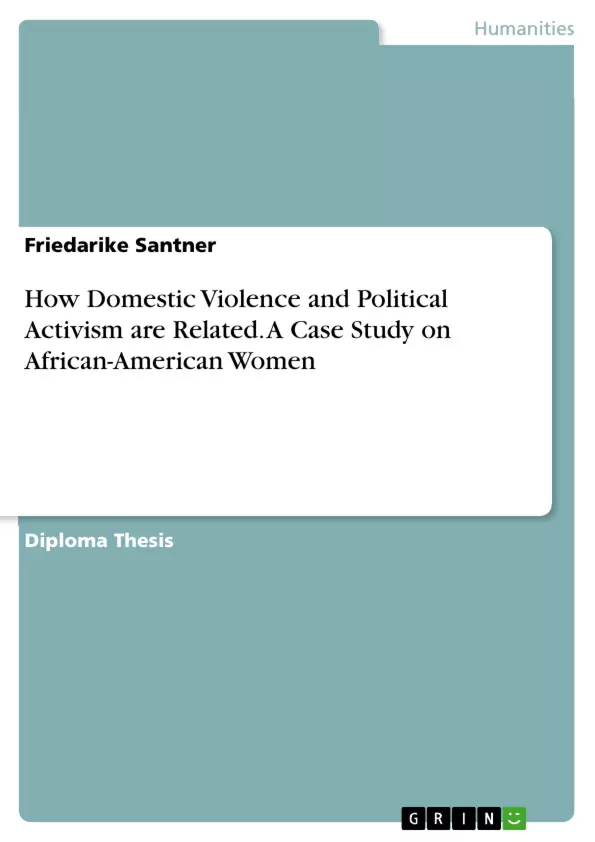Already before studying social and cultural anthropology and political science, I was an enthusiastic reader of African-American novelists, especially those authored by James Baldwin, and having viewed racism as one form of marginalization and exclusion, I wanted to learn and gain knowledge about this phenomenon and enrolled for these two disciplines. Specializing on African politics in my study, I nevertheless remained interested in the African-American experience and decided to write my thesis on an issue that would be in some proximity to the latter.
Through contacts with African-American social and political activists, I finally encountered an issue that I wanted to tackle, it is a circumstance that, in my view then, constituted a contradiction, the gap between the enormous political and social activism of African-American women and on the other hand the high rate of domestic violence and sexual assault in U.S. Black communities.
Inhaltsverzeichnis (Table of Contents)
- Introduction
- a) Research Question
- b) Preview of the Topics
- c) Research Methods
- d) Notes on Language Use, Terms, and the Discourse
- 1 Political Challenges for Black Communities
- 1.1 Racism Not Just a Personal Ideology
- 1.2 The Slavery Economy and African-American Identity
- 1.3 The Focus on Men in the Community's Collective Memory
- 1.4 The Creation of Anger
- 1.5 Drugs
- 1.6 Women Have Been Ignored By History
- 2 African-American Movements and Women's Engagement in Them
- 2.1 Black Political Ideas
- 2.1.1 Black nationalism
- 2.1.2 Pan-Africanism
- 2.1.3 Afrocentrism
- 2.1.4 A Word on Them All Together
- 2.2 Women in the Struggle
- 2.2.1 Lacking Acknowledgement and the Presence of Women
- 2.2.2 Where Does the Idea of Domination of Women Come From?
- 2.2.3 Did Women Contribute in Different Ways?
- 3 Violence Towards African-American Women
- 3.1 Structural Violence
- a) African-American Women's Health
- b) The Most Humiliating Images Were Put Out on Black Women
- c) Media Influence
- 3.2 Direct Violence
- 3.2.1 Some Stats and Information on Intimate Partner Violence
- 3.2.2 Seeking Help and Breaking Out
- 4 How Is Violence Towards Women Dealt With
- 4.1 Concepts of Violence Towards Black Women
- 4.2 The Perception of Violence Towards Women
- 4.3 The Approach in Local Politics
- 4.3.1 Televised Confrontations
- a) Washington v. Tyson
- b) Hill v. Thomas
- c) Which Effects Did the Trials Have?
- 4.3.2 Examples for Awareness Building Efforts
- 4.4 Resources for Providing Help
- 4.3 The Process of Increasing Awareness on Sexual Violence
- 5 Attempting to Correct the Situation. Black Women Correcting the Discourse
- 5.1 Notions of Sisterhood v. Thinking Global ?
- 5.1.1 Notions of Black Sisterhood
- 5.1.2 Networking Among Women of Color
- 5.1.3 The Black-White Divide
- 5.2 Self-Definition and Activism
- 5.2.1 Self-Definition in Black Women's Literature
- 5.2.2 Correction of Images in U.S. Media
- 5.2.3 Internet
- 5.3 The Potentials and Conservative Counter-Tendencies
Zielsetzung und Themenschwerpunkte (Objectives and Key Themes)
This thesis examines the correlation between the high levels of domestic violence and sexual assault against African-American women in the United States and their significant involvement in political movements throughout American history. The author seeks to explore the complex interplay of these seemingly contradictory realities.
- The historical and social context of racism and violence against African-American women
- The political activism and engagement of African-American women in various movements
- The influence of structural violence and its impact on African-American women
- The prevalence of direct violence, particularly intimate partner violence, within Black communities
- The challenges in addressing violence against African-American women and the potential for change through activism and community efforts
Zusammenfassung der Kapitel (Chapter Summaries)
The introduction presents the author's research question, which explores the potential link between the political activism of African-American women and the high rates of violence against them. The chapter also outlines the research methods used, discusses language use, and provides context for the work.
Chapter 1 delves into the political challenges faced by Black communities, highlighting the pervasive nature of racism and the legacy of slavery. The chapter examines the focus on men in the community's collective memory, the resulting anger, and the role of drugs in perpetuating these challenges.
Chapter 2 explores the engagement of African-American women in various political movements, including Black nationalism, Pan-Africanism, and Afrocentrism. It examines the historical lack of acknowledgment and the presence of women in these movements and seeks to understand if women contributed in different ways.
Chapter 3 focuses on violence towards African-American women, specifically exploring the concepts of structural and direct violence. The chapter examines the effects of structural violence on Black women's health, media influence, and the prevalence of intimate partner violence.
Chapter 4 examines how violence towards African-American women is dealt with in society. It delves into the perception of violence, the approach taken in local politics, and the resources available to those seeking help. The chapter also examines the role of televised confrontations in raising awareness about sexual violence.
Chapter 5 focuses on the efforts of African-American women to correct the discourse around violence and activism. It explores the notions of sisterhood, the importance of networking, and the challenges of the Black-White divide. The chapter also discusses the potential for self-definition and activism in addressing these issues.
Schlüsselwörter (Keywords)
This thesis explores the interconnectedness of African-American women's political activism, domestic violence, and the social and historical realities of racism and sexism in the United States. Key terms include: African-American women, political activism, domestic violence, sexual assault, structural violence, Black nationalism, Pan-Africanism, Afrocentrism, Black feminism, and community empowerment.
- Citation du texte
- Friedarike Santner (Auteur), 2002, How Domestic Violence and Political Activism are Related. A Case Study on African-American Women, Munich, GRIN Verlag, https://www.grin.com/document/11037



